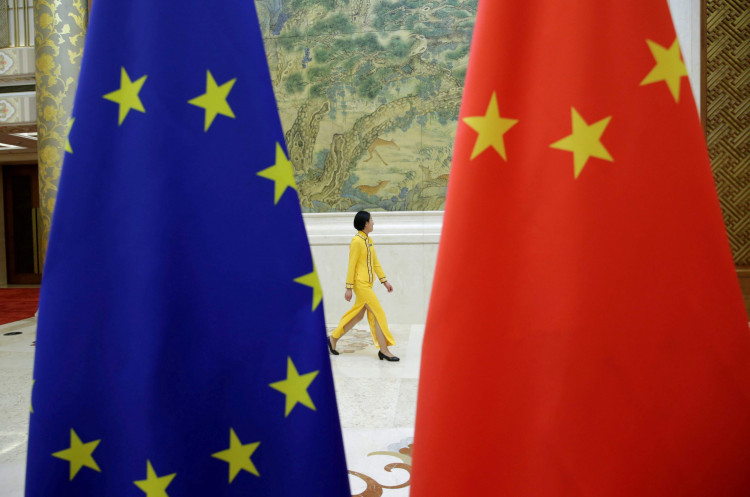In 2023, the semiconductor world is buzzing. While Nvidia takes the spotlight as the premier reveler, European chip manufacturers are a close second. Fueled primarily by automotive chips and SiC, Europe's chipmakers are experiencing a financial windfall. Having tasted success, they now set their sights on even grander futures, positioning themselves across broader arenas.
The recent approval of the "European Chip Act" has pressed the accelerator on Europe's semiconductor journey. Leading wafer factories like TSMC, Intel, and GlobalFoundries have reaped substantial fiscal subsidies. Yet, beneath this prosperous facade, the potential risks faced by Europe's semiconductor growth are becoming apparent.
Betting Big on SiC with New Wafer Factories
The rapid growth of the SiC market has caught many industry insiders off guard. Its demand isn't just limited to the automotive sector, but is also soaring in areas such as solar energy, energy storage, and high-power EV charging. European semiconductor giants like Infineon and STMicroelectronics have quickly realized the potential of the SiC market and are now engaged in a race to build the best facilities.
On August 8, 2023, Infineon announced a significant expansion of its wafer factory in Kulim, Malaysia. Over the next five years, the company plans to invest up to 50 billion euros in the construction of the third phase of this facility, aiming to establish the world's largest 200mm SiC wafer factory. Their confidence stems from roughly 50 billion euros worth of new design orders from the automotive and industrial sectors, along with an advanced payment of around 10 billion euros.
Infineon projects that, with this latest investment combined with planned modifications to their Filaach and Kulim plants, they could see annual revenues from SiC reach approximately 70 billion euros by 2030. This forthcoming production hub will play a pivotal role in helping Infineon achieve its goal of capturing 30% of the global SiC market share by 2030.
European Chip Titans Place Their Bets on RISC-V
Recently, leading European automotive electronic chip companies, including Bosch, Qualcomm, Infineon, Nordic, and NXP, jointly declared their intention to invest in a joint venture in Germany. This venture, centered around the open-source RISC-V architecture, aims to boost the global application of RISC-V chips. Initially focused on automotive applications, the scope will eventually expand to include IoT and mobile sectors. This collective investment and collaboration indicate their shared confidence in the future of the RISC-V architecture.
For these chip companies, each has its strategic game plan for RISC-V. Qualcomm, having experienced a somewhat strained relationship with Arm, views RISC-V as a controllable alternative. Qualcomm's investment in RISC-V has spanned over five years, and many of their products already incorporate RISC-V microcontrollers. Meanwhile, Infineon and NXP see potential in automotive processors based on RISC-V, and Nordic zeroes in on low-power IoT wireless technologies.
Several factors underline their push towards RISC-V:
- RISC-V, as an open-source architecture, boasts flexibility and customization capabilities. It doesn't come with hefty licensing fees and can cater to varied sector needs, reducing reliance on specific suppliers.
- As automotive electronic systems grow increasingly intricate, the demand for high-performance, energy-efficient, and dependable chips rises. RISC-V provides the flexibility required to adapt to evolving market needs.
- Adopting RISC-V is also a strategic move to mitigate supply chain risks and avoid being ensnared in semiconductor wars. Arm's licensing has been restricted by the US, particularly towards China. In contrast, RISC-V shifted its foundation to Switzerland in 2019, renaming itself "RISC-V International," signaling its independence from US political influences. Given that a significant portion of these European chip companies' business comes from Chinese clients, pivoting to RISC-V appears to be a wise alternative route.
Moreover, with strong backing from Chinese manufacturers in software, hardware, compiler, developer tools, and ecosystems, RISC-V is rapidly catching up.
Additionally, the establishment of such joint ventures could stimulate technological innovation and competitiveness in European semiconductors. Amid intensifying global semiconductor competition, the collaboration between these European chip powerhouses stands out. Despite their inherent competition, these firms have chosen to collaborate, which could give their joint venture a competitive edge in swiftly developing and promoting RISC-V products.
Real Gold and Silver, Crazy Subsidies
Nowadays, various countries are putting forth real financial resources to develop semiconductors at the national level, and the European Union is no exception. The "European Chip Act" was first introduced in February 2022, and by July 25, 2023, it was officially passed by 22 EU member states. The act aims to mobilize €43 billion to promote the European semiconductor industry by offering subsidies, attracting investments, and encouraging research and development. The ultimate goal is to increase the market share of chips produced in Europe from the current 10% to about 20% by 2030. A major purpose of this is to rejuvenate the European chip manufacturing industry and attract foundries such as TSMC, Samsung, and Intel.
Since the proposal of the chip act in Europe, many manufacturers have indeed been attracted to set up factories, with most of them being located in Germany, as mentioned in the article "The Influx of New Foundries in Europe." Now, with the passage of the "European Chip Act," the allocation of subsidies has also begun.
Intel has promised to establish a leading wafer factory near Magdeburg, Germany, and a state-of-the-art chip packaging factory in Poland. The German wafer factory is expected to have an investment of $33 billion, serving Intel products and Intel foundry service customers. On June 19, 2023, Intel signed an agreement with the German government, which will cover one-third of the costs (€11 billion). This is the largest foreign direct investment in the country's modern history. The Polish testing plant will have an investment of $4.6 billion and will help meet Intel's anticipated key demands for packaging and testing capabilities by 2027.
Following this, TSMC, Bosch, Infineon, and NXP announced a joint investment in the European Semiconductor Manufacturing Company (ESMC), constructing a €10 billion 300mm wafer factory in Dresden, Germany. In recent years, there have been doubts about whether TSMC, the wafer foundry giant, intended to build a factory in Germany. On August 8th, TSMC's board of directors approved an investment within the limit of €3.499 billion (approximately $3.884 billion) in the primarily-held German subsidiary ESMC GmbH to provide advanced semiconductor manufacturing services. Once approved by the regulatory authority and meeting other conditions, TSMC will hold a 70% stake, while Bosch, Infineon, and NXP will each hold 10%, with TSMC operating it.
The ESMC wafer factory is expected to adopt TSMC's 28/22nm planar complementary metal-oxide-semiconductor (CMOS) and 16/12nm FinFET process technology, with a monthly capacity of about 40,000 12-inch wafers. The factory is scheduled to be built in the second half of 2024 and to start production by the end of 2027. This wafer factory mainly produces chips of mature processes, which responds to the rapidly growing demand in the automotive and industrial sectors, as chips in areas such as automotive and industrial sectors often do not use advanced processes.
In July 2022, STMicroelectronics and GlobalFoundries collaborated to establish a new joint-operated 300mm semiconductor manufacturing factory near the existing factory in Crolles, France, to produce products with FD-SOI or fully depleted silicon-on-insulator semiconductor manufacturing technology. On June 5, 2023, both companies finalized the agreement to establish a new 300mm semiconductor manufacturing factory in France. The French government will provide a subsidy of €7.5 billion for this new factory. This aid measure complies with the objectives stipulated in the "European Chip Act" and is part of the "France 2030" plan, which has recently been approved by the European Commission. The EU stated that the aid would be given directly to ST and GF.
Furthermore, SiC giant Wolfspeed is partnering with its collaborator ZF Friedrichshafen to build the largest SiC factory in Germany. They are also expected to receive European chip subsidies, with the joint venture seeking subsidies for about 25% of the costs, roughly €750 million. Previously, Wolfspeed announced an investment of $3 billion to build a highly automated 200mm SiC wafer manufacturing factory in Saarland, Germany. The factory will be located on a 35-acre (14-hectare) former coal-fired power plant in Saarland. It will be Wolfspeed's first factory in Europe and is set to become the world's largest silicon carbide chip production plant. Construction of the wafer factory is expected to begin in the first half of 2023, with mass production planned within four years. The new factory is part of Wolfspeed's $6.5 billion global capacity expansion plan and will support its long-term revenue outlook of $4 billion for the fiscal year 2027.
In general, the EU's chip act is indeed effective, because without the "European Chip Act", these investments would not have been possible in Europe. Looking at it this way, only South Korea has not yet built a factory in Europe. Last weekend, when German Chancellor Olaf Scholz visited Seoul, he once again discussed the semiconductor issue with his South Korean counterpart and called on South Korea to invest in Europe to strengthen the supply chain.
The Biggest Challenges of Europe's Semiconductor Development
Europe indeed has significant advantages in the semiconductor market. For example, in areas such as automotive, aerospace, and industrial automation applications, the European semiconductor industry has established a vital position. Moreover, Europe has top-notch innovative research facilities, like Imec located in Leuven, Belgium. However, there are also significant challenges in this sector that urgently need addressing.
The Challenge of the Talent Gap
A shortage of talent is a major challenge. The economic success of wafer fabs largely relies on the supply of specialized labor in the semiconductor industry. Without the right skilled talents, any new or expanding factory cannot make a significant impact. Currently, Europe is facing a serious shortage of qualified workers, a situation that may further worsen over the next decade.
As mentioned earlier, most of Europe's primary wafer fabs are located in Germany, with one-third of the semiconductor engineers coming from the state of Saxony in Germany. The region has over 76,000 employees working in the local chip industry, partly due to the clustering of local research institutions, semiconductor companies, and technical universities. But for Germany and Europe as a whole, this is still far from enough.
According to the German Labor Department, from June 2021 to June 2022, the German semiconductor industry was short of 62,000 workers. Moreover, according to research by IW Koeln, within the next 10 to 12 years, 28% of electrical engineering experts and 33% of engineering supervisors in the German semiconductor industry will reach retirement age. Therefore, with an aging population and a decreasing number of Germans entering the labor market, there is an urgent need for a large number of foreign skilled workers. While Europe is reforming its immigration laws to make it easier to attract foreign technicians to Germany, it still cannot compete with the high salaries offered in countries like Singapore in terms of attracting technical talent.
Complexity of Industry Demand and Talent Structure
Each step of the semiconductor process requires different types of specialists. According to Deloitte, a large wafer fab requires about 4,000 workers with production engineering, logistics, support, and production operation skills. The German Business Daily reports that by 2030, the industry will have more than half of its positions facing vacancies.
There is also complexity in the talent flow within the EU. Although workers can move freely between EU countries, language becomes a barrier, especially for technical work. This is not the case in Japan or the United States. Labor laws in the EU also differ significantly from other jurisdictions, and there are differences in the education system (universities and vocational training).
In conclusion, for any country or region to achieve complete self-sufficiency throughout the semiconductor supply chain, it's an extremely challenging and intricate task.



